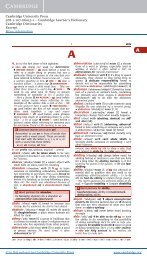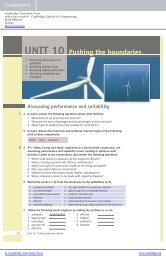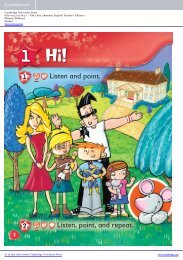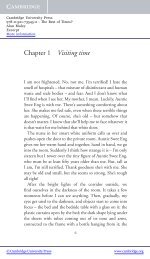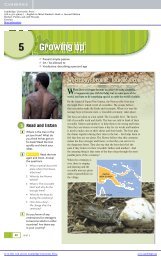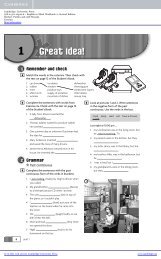A Chronicle of Timekeeping
A Chronicle of Timekeeping
A Chronicle of Timekeeping
Create successful ePaper yourself
Turn your PDF publications into a flip-book with our unique Google optimized e-Paper software.
Cambridge University Press<br />
978-0-521-17378-0 - Cambridge IELTS 8<br />
Cambridge ESOL<br />
Excerpt<br />
More information<br />
Test 1<br />
SECTION 1 Questions 1–10<br />
Questions 1 and 2<br />
Choose the correct letter, A, B or C.<br />
1 In the lobby <strong>of</strong> the library George saw<br />
10<br />
Example<br />
In the library George found<br />
A a book.<br />
B a brochure.<br />
C a newspaper.<br />
A a group playing music.<br />
B a display <strong>of</strong> instruments.<br />
C a video about the festival.<br />
LISTENING<br />
2 George wants to sit at the back so they can<br />
A see well.<br />
B hear clearly.<br />
C pay less.<br />
© in this web service Cambridge University Press<br />
www.cambridge.org
Cambridge University Press<br />
978-0-521-17378-0 - Cambridge IELTS 8<br />
Cambridge ESOL<br />
Excerpt<br />
More information<br />
Questions 3–10<br />
Complete the form below.<br />
Write NO MORE THAN TWO WORDS AND/OR A NUMBER for each answer.<br />
Summer music festival<br />
Booking form<br />
NAME: George O’Neill<br />
ADDRESS: 3 ........................, Westsea<br />
POSTCODE: 4 ........................<br />
TELEPHONE: 5 ........................<br />
Listening<br />
Date Event Price per ticket No. <strong>of</strong> tickets<br />
5 June Instrumental group<br />
– Guitarrini<br />
17 June Singer (price<br />
includes<br />
6 ........................ in<br />
the garden)<br />
22 June 7 ........................<br />
(Anna Ventura)<br />
23 June Spanish Dance &<br />
Guitar Concert<br />
£7.50 2<br />
£6 2<br />
£7.00 1<br />
8 £ ........................ 9 .......................<br />
NB Children / Students / Senior Citizens have 10 ........................ discount on all<br />
tickets.<br />
© in this web service Cambridge University Press<br />
11<br />
www.cambridge.org
Cambridge University Press<br />
978-0-521-17378-0 - Cambridge IELTS 8<br />
Cambridge ESOL<br />
Excerpt<br />
More information<br />
Test 1<br />
SECTION 2 Questions 11–20<br />
Questions 11–15<br />
Complete the sentences below.<br />
Write NO MORE THAN TWO WORDS AND/OR A NUMBER for each answer.<br />
Questions 16–18<br />
Choose THREE letters, A–G.<br />
Which THREE things can students have with them in the museum?<br />
12<br />
A food<br />
B water<br />
C cameras<br />
D books<br />
E bags<br />
F pens<br />
G worksheets<br />
The Dinosaur Museum<br />
11 The museum closes at ........................ p.m. on Mondays.<br />
12 The museum is not open on ......................... .<br />
13 School groups are met by tour guides in the ......................... .<br />
14 The whole visit takes 90 minutes, including ......................... minutes for the<br />
guided tour.<br />
15 There are ........................ behind the museum where students can have lunch.<br />
© in this web service Cambridge University Press<br />
www.cambridge.org
Cambridge University Press<br />
978-0-521-17378-0 - Cambridge IELTS 8<br />
Cambridge ESOL<br />
Excerpt<br />
More information<br />
Questions 19 and 20<br />
Choose TWO letters, A–E.<br />
Which TWO activities can students do after the tour at present?<br />
A build model dinosaurs<br />
B watch fi lms<br />
C draw dinosaurs<br />
D fi nd dinosaur eggs<br />
E play computer games<br />
© in this web service Cambridge University Press<br />
Listening<br />
13<br />
www.cambridge.org
Cambridge University Press<br />
978-0-521-17378-0 - Cambridge IELTS 8<br />
Cambridge ESOL<br />
Excerpt<br />
More information<br />
Test 1<br />
SECTION 3 Questions 21–30<br />
Questions 21–24<br />
Choose the correct letter, A, B or C.<br />
14<br />
Field Trip Proposal<br />
21 The tutor thinks that Sandra’s proposal<br />
A should be re- ordered in some parts.<br />
B needs a contents page.<br />
C ought to include more information.<br />
22 The proposal would be easier to follow if Sandra<br />
A inserted subheadings.<br />
B used more paragraphs.<br />
C shortened her sentences.<br />
23 What was the problem with the formatting on Sandra’s proposal?<br />
A Separate points were not clearly identifi ed.<br />
B The headings were not always clear.<br />
C Page numbering was not used in an appropriate way.<br />
24 Sandra became interested in visiting the Navajo National Park through<br />
A articles she read.<br />
B movies she saw as a child.<br />
C photographs she found on the internet.<br />
© in this web service Cambridge University Press<br />
www.cambridge.org
Cambridge University Press<br />
978-0-521-17378-0 - Cambridge IELTS 8<br />
Cambridge ESOL<br />
Excerpt<br />
More information<br />
Questions 25–27<br />
Choose THREE letters, A–G.<br />
Which THREE topics does Sandra agree to include in the proposal?<br />
A climate change<br />
B fi eld trip activities<br />
C geographical features<br />
D impact <strong>of</strong> tourism<br />
E myths and legends<br />
F plant and animal life<br />
G social history<br />
Questions 28–30<br />
Complete the sentences below.<br />
Write ONE WORD AND/OR A NUMBER for each answer.<br />
28 The tribal park covers ......................... hectares.<br />
29 Sandra suggests that they share the ........................ for transport.<br />
30 She says they could also explore the local ......................... .<br />
© in this web service Cambridge University Press<br />
Listening<br />
15<br />
www.cambridge.org
Cambridge University Press<br />
978-0-521-17378-0 - Cambridge IELTS 8<br />
Cambridge ESOL<br />
Excerpt<br />
More information<br />
Test 1<br />
SECTION 4 Questions 31–40<br />
Complete the notes below.<br />
Write ONE WORD ONLY for each answer.<br />
16<br />
Geography<br />
Studying geography helps us to understand:<br />
• the effects <strong>of</strong> different processes on the 31 ......................... <strong>of</strong> the Earth<br />
• the dynamic between 32 .......................... and population<br />
Two main branches <strong>of</strong> study:<br />
• physical features<br />
• human lifestyles and their 33 .........................<br />
Specifi c study areas: biophysical, topographic, political, social, economic,<br />
historical and 34 ......................... geography, and also cartography<br />
Key point: geography helps us to understand our surroundings and the<br />
associated 35 ........................<br />
What do geographers do?<br />
• fi nd data – e.g. conduct censuses, collect information in the form <strong>of</strong><br />
36 ........................ using computer and satellite technology<br />
• analyse data – identify 37 ........................, e.g. cause and effect<br />
© in this web service Cambridge University Press<br />
www.cambridge.org
Cambridge University Press<br />
978-0-521-17378-0 - Cambridge IELTS 8<br />
Cambridge ESOL<br />
Excerpt<br />
More information<br />
• publish fi ndings in form <strong>of</strong>:<br />
a) maps<br />
– easy to carry<br />
– can show physical features <strong>of</strong> large and small areas<br />
– BUT a two- dimensional map will always have some 38 .........................<br />
Listening<br />
b) aerial photos<br />
– can show vegetation problems, 39 .......................... density, ocean fl oor etc.<br />
c) Landsat pictures sent to receiving stations<br />
– used for monitoring 40 ......................... conditions etc.<br />
© in this web service Cambridge University Press<br />
17<br />
www.cambridge.org
Cambridge University Press<br />
978-0-521-17378-0 - Cambridge IELTS 8<br />
Cambridge ESOL<br />
Excerpt<br />
More information<br />
Test 1<br />
READING PASSAGE 1<br />
18<br />
READING<br />
You should spend about 20 minutes on Questions 1–13, which are based on Reading<br />
Passage 1 below.<br />
A <strong>Chronicle</strong> <strong>of</strong><br />
<strong>Timekeeping</strong><br />
Our conception <strong>of</strong> time depends on the way we measure it<br />
A According to archaeological evidence, at least 5,000 years ago, and long before the advent<br />
<strong>of</strong> the Roman Empire, the Babylonians began to measure time, introducing calendars<br />
to co- ordinate communal activities, to plan the shipment <strong>of</strong> goods and, in particular, to<br />
regulate planting and harvesting. They based their calendars on three natural cycles: the<br />
solar day, marked by the successive periods <strong>of</strong> light and darkness as the earth rotates on<br />
its axis; the lunar month, following the phases <strong>of</strong> the moon as it orbits the earth; and<br />
the solar year, defi ned by the changing seasons that accompany our planet’s revolution<br />
around the sun.<br />
B Before the invention <strong>of</strong> artifi cial light, the moon had greater social impact. And, for those<br />
living near the equator in particular, its waxing and waning was more conspicuous than<br />
the passing <strong>of</strong> the seasons. Hence, the calendars that were developed at the lower latitudes<br />
were infl uenced more by the lunar cycle than by the solar year. In more northern climes,<br />
however, where seasonal agriculture was practised, the solar year became more crucial. As<br />
the Roman Empire expanded northward, it organised its activity chart for the most part<br />
around the solar year.<br />
C Centuries before the Roman Empire, the Egyptians had formulated a municipal calendar<br />
having 12 months <strong>of</strong> 30 days, with fi ve days added to approximate the solar year. Each<br />
period <strong>of</strong> ten days was marked by the appearance <strong>of</strong> special groups <strong>of</strong> stars called decans.<br />
At the rise <strong>of</strong> the star Sirius just before sunrise, which occurred around the all- important<br />
annual fl ooding <strong>of</strong> the Nile, 12 decans could be seen spanning the heavens. The cosmic<br />
signifi cance the Egyptians placed in the 12 decans led them to develop a system in which<br />
each interval <strong>of</strong> darkness (and later, each interval <strong>of</strong> daylight) was divided into a dozen<br />
equal parts. These periods became known as temporal hours because their duration varied<br />
according to the changing length <strong>of</strong> days and nights with the passing <strong>of</strong> the seasons.<br />
Summer hours were long, winter ones short; only at the spring and autumn equinoxes<br />
© in this web service Cambridge University Press<br />
www.cambridge.org
Cambridge University Press<br />
978-0-521-17378-0 - Cambridge IELTS 8<br />
Cambridge ESOL<br />
Excerpt<br />
More information<br />
Reading<br />
were the hours <strong>of</strong> daylight and darkness equal. Temporal hours, which were fi rst adopted<br />
by the Greeks and then the Romans, who disseminated them through Europe, remained<br />
in use for more than 2,500 years.<br />
D In order to track temporal hours during the day, inventors created sundials, which indicate<br />
time by the length or direction <strong>of</strong> the sun’s shadow. The sundial’s counterpart, the water<br />
clock, was designed to measure temporal hours at night. One <strong>of</strong> the fi rst water clocks<br />
was a basin with a small hole near the bottom through which the water dripped out. The<br />
falling water level denoted the passing hour as it dipped below hour lines inscribed on the<br />
inner surface. Although these devices performed satisfactorily around the Mediterranean,<br />
they could not always be depended on in the cloudy and <strong>of</strong>ten freezing weather <strong>of</strong><br />
northern Europe.<br />
E The advent <strong>of</strong> the mechanical clock meant that although it could be adjusted to maintain<br />
temporal hours, it was naturally suited to keeping equal ones. With these, however, arose<br />
the question <strong>of</strong> when to begin counting, and so, in the early 14th century, a number <strong>of</strong><br />
systems evolved. The schemes that divided the day into 24 equal parts varied according<br />
to the start <strong>of</strong> the count: Italian hours began at sunset, Babylonian hours at sunrise,<br />
astronomical hours at midday and ‘great clock’ hours, used for some large public clocks<br />
in Germany, at midnight. Eventually these were superseded by ‘small clock’, or French,<br />
hours, which split the day into two 12- hour periods commencing at midnight.<br />
F The earliest recorded weight - driven mechanical clock was built in 1283 in Bedfordshire<br />
in England. The revolutionary aspect <strong>of</strong> this new timekeeper was neither the descending<br />
weight that provided its motive force nor the gear wheels (which had been around for at<br />
least 1,300 years) that transferred the power; it was the part called the escapement. In the<br />
early 1400s came the invention <strong>of</strong> the coiled spring or fusee which maintained constant<br />
force to the gear wheels <strong>of</strong> the timekeeper despite the changing tension <strong>of</strong> its mainspring.<br />
By the 16th century, a pendulum clock had been devised, but the pendulum swung in a<br />
large arc and thus was not very effi cient.<br />
G To address this, a variation on the original escapement was invented in 1670, in England.<br />
It was called the anchor escapement, which was a lever- based device shaped like a ship’s<br />
anchor. The motion <strong>of</strong> a pendulum rocks this device so that it catches and then releases<br />
each tooth <strong>of</strong> the escape wheel, in turn allowing it to turn a precise amount. Unlike<br />
the original form used in early pendulum clocks, the anchor escapement permitted the<br />
pendulum to travel in a very small arc. Moreover, this invention allowed the use <strong>of</strong> a long<br />
pendulum which could beat once a second and thus led to the development <strong>of</strong> a new fl oor-<br />
standing case design, which became known as the grandfather clock.<br />
H Today, highly accurate timekeeping instruments set the beat for most electronic devices.<br />
Nearly all computers contain a quartz- crystal clock to regulate their operation. Moreover,<br />
not only do time signals beamed down from Global Positioning System satellites calibrate<br />
the functions <strong>of</strong> precision navigation equipment, they do so as well for mobile phones,<br />
instant stock- trading systems and nationwide power- distribution grids. So integral have<br />
these time- based technologies become to day- to- day existence that our dependency on<br />
them is recognised only when they fail to work.<br />
© in this web service Cambridge University Press<br />
19<br />
www.cambridge.org



